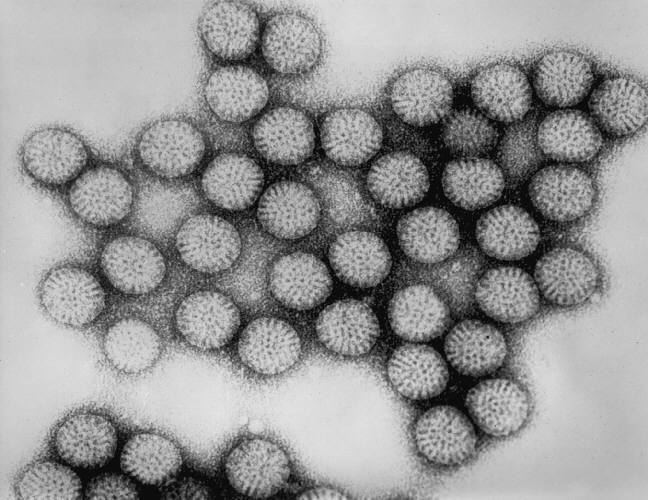Group Group III (dsRNA) Scientific name Reoviridae | Order Unassigned Rank Family | |
 | ||
Lower classifications Rotavirus, Rice ragged stunt virus, Oat sterile dwarf virus | ||
Reoviridae is a family of viruses. They have a wide host range, including vertebrates, invertebrates, plants, and fungi. They are unique in that they lack lipid envelopes and package their genomes of discrete double-stranded segments of RNA within multi-layered capsids. Lack of a lipid envelope has allowed three-dimensional structures of these large complex viruses (diameter,∼600–1,000 nm) to be obtained. There are currently 87 species in this family, divided among 30 genera. Reoviruses can affect the gastrointestinal system (such as Rotavirus) and respiratory tract. The name "Reo-" is derived from respiratory enteric orphan viruses. The term "orphan virus" refers to the fact that some of these viruses have been observed not associated with any known disease. Even though viruses in the Reoviridae family have more recently been identified with various diseases, the original name is still used.
Contents
- Reoviridae
- Structure
- Life Cycle
- Multiplicity reactivation
- Taxonomy
- Other Reoviridae
- Therapeutic applications
- References
Reovirus infection occurs often in humans, but most cases are mild or subclinical. Rotavirus, however, can cause severe diarrhea and intestinal distress in children. The virus can be readily detected in feces, and may also be recovered from pharyngeal or nasal secretions, urine, cerebrospinal fluid, and blood. Despite the ease of finding Reovirus in clinical specimens, their role in human disease or treatment is still uncertain.
Some viruses of this family, such as Phytoreovirus and Oryzavirus, infect plants. Most of the plant-infecting reoviruses are transmitted between plants by insect vectors. The viruses replicate in both the plant and the insect, generally causing disease in the plant, but little or no harm to the infected insect.
Recently researchers at the University of Leeds have found that Reovirus stimulates the body's own immune system to kill off cancerous cells.
Reoviridae
Structure
Reoviruses are non-enveloped and have an icosahedral capsid composed of an outer (T=13) and inner (T=2) protein shell. The genomes of viruses in Reoviridae contain 10–12 segments which are grouped into three categories corresponding to their size: L (large), M (medium) and S (small). Segments range from about 0.2 to 3 kbp and each segment encodes 1–3 proteins (10-14 proteins in total). Reoviridae proteins are denoted by the Greek character corresponding to the segment it was translated from (the L segment encodes for λ proteins, the M segment encodes for μ proteins and the S segment encodes for σ proteins).
Life Cycle
Viruses in the family Reoviridae have genomes consisting of segmented, double-stranded RNA (dsRNA). Because of this, replication occurs exclusively in the cytoplasm and the virus encodes several proteins which are needed for replication and conversion of the dsRNA genome into (+)-RNAs. The virus can enter the host cell via a receptor on the cell surface. The receptor is not known but is thought to include sialic acid and junctional adhesion molecules (JAMs). The virus is partially uncoated by proteases in the endolysosome, where the capsid is partially digested to allow further cell entry. The core particle then enters the cytoplasm by a yet unknown process where the genome is transcribed conservatively causing an excess of (+) sense strands, which are used as mRNA templates to synthesize (−) sense strands. Viral particles begin to assemble in the cytoplasm 6–7 hours after infection. Translation takes place by leaky scanning, suppression of termination, and ribosomal skipping. The virus exits the host cell by monopartite non-tubule guided viral movement, cell to cell movement, and existing in occlusion bodies after cell death and remaining infectious until finding another host.
Multiplicity reactivation
Multiplicity reactivation (MR) is the process by which 2 or more virus genomes, each containing inactivating genome damage, can interact within an infected cell to form a viable virus genome. McClain and Spendlove demonstrated MR for three types of reovirus after exposure to ultraviolet irradiation. In their experiments, reovirus particles were exposed to doses of UV-light that would be lethal in single infections. However, when two or more inactivated viruses were allowed to infect individual host cells MR occurred and viable progeny were produced. As they stated, multiplicity reactivation by definition involves some type of repair. Michod et al. reviewed numerous examples of MR in different viruses, and suggested that MR is a common form of sexual interaction in viruses that provides the benefit of recombinational repair of genome damages.
Taxonomy
Group: dsRNA
The Reoviridae are divided into two subfamilies based on the presence of a "turret" protein on the inner capsid. From ICTV communications: "The name Spinareovirinae will be used to identify the subfamily containing the spiked or turreted viruses and is derived from 'reovirus' and the Latin word 'spina' as a prefix, which means spike, denoting the presence of spikes or turrets on the surface of the core particles. The term 'spiked' is an alternative to 'turreted', that was used in early research to describe the structure of the particle, particularly with the cypoviruses. The name Sedoreovirinae will be used to identify the subfamily containing the non-turreted virus genera and is derived from 'reovirus' and the Latin word 'sedo', which means smooth, denoting the absence of spikes or turrets from the core particles of these viruses, which have a relatively smooth morphology."
Other Reoviridae
Additionally, there is one proposed genus that has not yet been accepted by the ICTV:
Piscine reovirus is a Spinareovirinae-like virus that has not yet been classified.
Therapeutic applications
Although reoviruses are mostly nonpathogenic in humans, these viruses have served as very productive experimental models for studies of viral pathogenesis. Newborn mice are exquisitely sensitive to reovirus infection and have been used as the preferred experimental system for studies of reovirus pathogenesis.
The reoviruses have been demonstrated to have oncolytic (cancer-killing) properties, encouraging the development of reovirus-based therapies for cancer treatment.
Reolysin is a formulation of reovirus that is currently in clinical trials for the treatment of various cancers.
